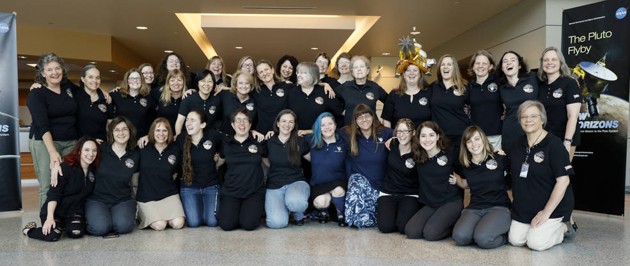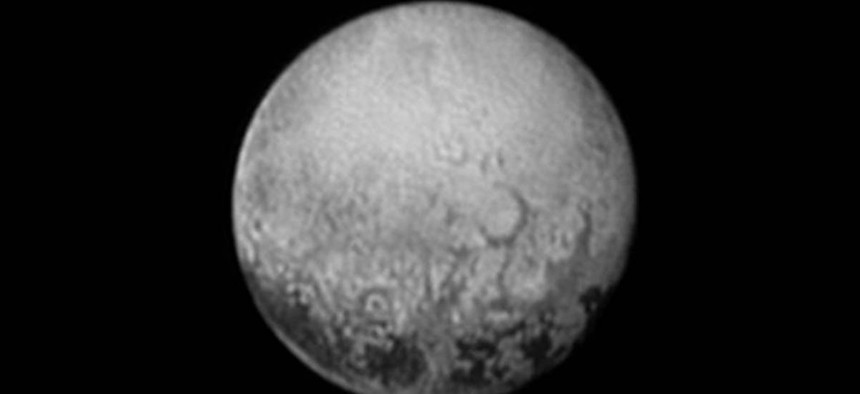The Women Who Rule Pluto
The New Horizons team may include more women staffers than any other NASA project in history.
For all the firsts coming out of the New Horizons mission—color footage of Pluto, photos of all five of its moons, and flowing datastreams about Pluto’s composition and atmosphere—there’s one milestone worth noting on Earth: This may be the mission with the most women in NASA history.
“I don't know whether it’s technically the most,” said Fran Bagenal, an astrophysicist who has worked on NASA missions for four decades. “But I was involved in Voyager going back to the ’70s, as well as Galileo, and a whole bunch of missions. I can say: There are certainly a lot of us.”
The New Horizons team includes about 200 people today, but there have been thousands of scientists and engineers who have contributed to the mission since it began more than a decade ago. Women make up about one-quarter of the flyby team, those responsible for the high-stakes mission taking place this month,according to NASA. The flyby is planned for Tuesday morning, when NASA’s probe is scheduled to be within about 8,000 miles of Pluto.
Bagenal is not the only one who has noticed the “dramatic change” in number of women on the team. It’s meaningful at a time when women who are scientists routinely face gender-based discrimination at work.
“I distinctly remember on more than one occasion, when I've been the only woman in the room, people thought I was the secretary,” said Kimberly Ennico, an astrophysicist who builds and calibrates space instruments on the New Horizons mission. “It got to the point that there were some times in which people would ask me to take notes and I would have to say, ‘I take notes for me, not for you.’”
Ennico says it never dawned on her, until New Horizons, that she might someday be on a mission where women would outnumber the men. “From personal experience, this will be my fourth space mission, and by far this mission has the most women on it,” she said. “To be in a room full of more women than men or equal number of women and men? First of all, it feels normal, which is wonderful. Whenever it was only one women in the room or two it always felt awkward.”
There’s a sense among many scientists, including Ennico, that the fight for equality has “totally slowed down,” she says. “We’re not equal. I'm sorry to say we’re not there yet. I think when we get to the point in which we don’t need to call attention to whether you’re a woman or a man, that’s when we have succeeded.”
Ongoing discrimination against women in science is well documented. In 2012, researchers at Yale found that biologists, chemists, and physicists saw men as more favorable job candidates than women, and were willing to pay men $4,000 more per year compared with women who had the same qualifications. And despite widespread evidence of such imbalances, earlier this year, researchers found that men “flipped out,” as The Washington Post put it, even when presented with proof of gender bias in science, many of them publishing sexist remarks in response.

Women of the New Horizons flyby team at Johns Hopkins Applied Physics Laboratory (SwRI / JHUAPL)
In April, a reviewer for the journal PLOS ONE told female researchers that their work would be improved if they could “find one or two male biologists to work with (or at least obtain internal peer review from, but better yet as active co-authors).” And in June, a Nobel Prize-winning biochemist suggested that “girls” cause trouble in laboratory settings because “you fall in love with them, they fall in love with you, and when you criticize them they cry.” (Many women responded by making fun of the comment.) The dismal state of affairs in labs and universities is arguably a distraction itself. Which may help explain why many women in science are reluctant to discuss gender at all.
“We do have a lot of women on this mission,” said Cathy Olkin, a planetary scientist and a co-investigator for New Horizons. “And I’m not really sure why that is. We have an amazing team and I’m not sure how gender fits into that.”
“I would agree that there are a higher percentage of women working on this project,” Alice Bowman, the missions operation manager for New Horizons, told me. “When I look at a team and somebody says, ‘Oh, look at the mix of diversity on your team,’ it’s something that I don't see unless someone points it out.”







